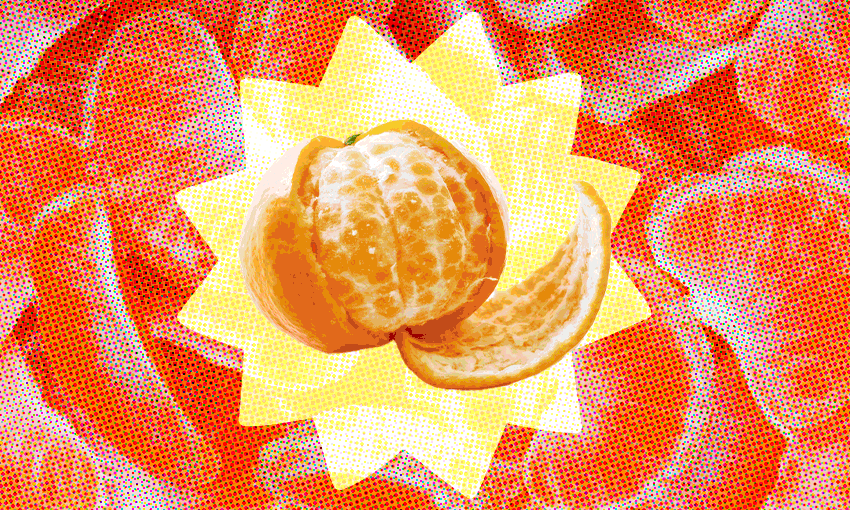They’re flawless on their own as a self-contained lunchbox snack. But mandarins are also capable of so much more.
For the past week, everyone in my house has been coughing, sniffling and shuffling around in dressing gowns – so thank goodness it’s mandarin season. We’ve been popping juicy little mandarin segments constantly.
Not only are mandarins a tasty treat and vitamin C dose (one-and-a-half mandarins provide a third of your daily requirement), they’re also a delight to peel. Spending five minutes surgically removing their fine strings of white pith is a perfect calming exercise, which I would highly recommend as a stress reduction break during the workday. What’s more “mindful” than a miniature fruit manicure?
If you’ve ever wondered about canned mandarins, and how they get the mandarin segments quite so naked (no membranes at all, just segment-shaped juice pods!), this is how it’s done. The segments are peeled in a chemical process, first being scalded in hot water, then bathed in a lye solution which dissolves away the membrane. But don’t worry – they’re then rinsed in clean water, and heat processed to remove bacteria.
Even for a mandarin peeling enthusiast, those are great lengths to undergo for the perfect peel.
Citrus ancestry
Whenever I wondered about citrus in the past (an infrequent pastime, I admit), I assumed that the original citrus ancestors were oranges, lemons, limes and perhaps grapefruit. Mandarins, on the other hand, must have been invented in a lab by a scientist with school-age children, who was looking for the perfect sweet lunchbox fruit.
Well. How very wrong I was.
It turns out that mandarins are one of the pure citrus ancestors, along with the citron (like a huge, lumpy lemon) and the pomelo (like a giant, sweet grapefruit). Most modern varieties of mandarin are crossed with pomelo, which is what makes them sweet.
Our common orange was first parented by a non-pure mandarin and a pomelo. Even the lemon, the most classic of citrus, is a hybrid of a sour orange and a citron – but the sour orange itself is in fact another cross between a mandarin and a pomelo. And the lime, for goodness’ sake, is a cross between a lemon and a key lime (which is smaller and tarter than a “regular” lime).
Oh, and here’s some extra for experts: a clementine is a cross between a mandarin and a standard orange; a satsuma is a mandarin-pomelo cross, heavy on the pomelo; a tangelo is a cross between a tangerine and a pomelo, and a tangor is a cross between a tangerine and an orange.
If that isn’t enough to scramble your mind with citrusy Venn diagrams, I don’t know what is.
Where to find mandarins
For those lucky enough to have a mandarin tree, the season can really overwhelm with fruit – a mature mandarin tree can produce 75 – 80 kilograms of fruit each year.
Over at the supermarkets, we have a curious plot twist this week: Pak’nSave has the priciest mandarins, selling satsumas for $5.99/kg (around 90 cents a pop). New World mandarins are $5.49/kg, while at Countdown the mandarins are $5.80/kg, with the option of an Odd Bunch 1kg bag for $4.60.
Price comparison this week is a little tricky with Supie, which is selling 3 large mandarins (400g – 550g) for $2.49, or a bag (an estimated 9 mandarins) for $3.99. A sweet, juicy steal.
How to make mandarins amazing
As we all know, the fact that mandarins come in their own little protective package make them the perfect snack to stash in a lunchbox or work bag. However, there’s more to mandarins than delightful snacking.
With oranges only just coming into season, mandarins are still the way to go when it comes to bright, citrusy salads and salsas. My favourites are roasted kūmara, feta, walnut, and mandarin salad in a balsamic dressing, and a mint, mandarin and spring onion salsa as a side or for topping fish burgers and tacos.
In Chinese cuisine, dried mandarin peel, called chen pi, is used to flavour sauces, teas, and desserts. The essential oil from the zest is also used for flavouring sweets, gelatin, baking, liqueur and ice cream. While it doesn’t exactly feel like ice cream making weather, the idea of chewy mandarin-zest cookies is certainly tempting me this weekend.
Wyoming Paul is the co-founder of Grossr, a recipe management website where you can create recipes, discover chefs and follow meal plans.
Read all the previous Ingredients of the Week here.





















Discussion about this post